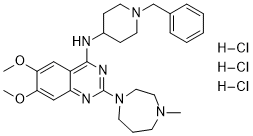| Cas No.: | 1392399-03-9 |
| Chemical Name: | BIX01294 HCl |
| Synonyms: | BIX 01294;BIX 01294 Trihydrochloride Hydrate;Trihydrochloride Hydrate;BIX 01294 Trihydrochloride;4-Quinazolinamine, 2-(hexahydro-4-methyl-1H-1,4-diazepin-1-yl)-6,7-dimethoxy-N-[1-(phenylmethyl)-4-piperidinyl]-, hydrochloride (1:3);N-(1-Benzyl-4-piperidinyl)-6,7-dimethoxy-2-(4-methyl-1,4-diazepan -1-yl)-4-quinazolinamine trihydrochloride;2-(Hexahydro-4-methyl-1H-1,4-diazepin-1-yl)-6,7-dimethoxy-N-[1-(phenylmethyl)-4-piperidinyl]-4-quinazolinamine Trihydrochloride Hydrate;2-(Hexahydro-4-methyl-1H-1,4-diazepin-1-yl)-6,7-dimethoxy-N-[1-(phenylmethyl)-4-piperidinyl]-4-quinazolinamine hydrochloride (1:3) |
| SMILES: | Cl.Cl.Cl.CN1CCCN(C2N=C(NC3CCN(CC4C=CC=CC=4)CC3)C3=CC(=C(C=C3N=2)OC)OC)CC1 |
| Formula: | C28H41Cl3N6O2 |
| M.Wt: | 600.026 |
| Purity: | >98% |
| Sotrage: | 2 years -20°C Powder, 2 weeks 4°C in DMSO, 6 months -80°C in DMSO |
| Description: | BIX-01294 trihydrochloride is a reversible and highly selective G9a Histone Methyltransferase inhibitor, with an IC50 of 2.7 μM in DELFIA assay. BIX-01294 trihydrochloride specifically inhibits G9a (H3K9me2) and GLP enzyme (H3K9me3), with IC50s of 1.7 μM and 38 μM, respectively. BIX-01294 trihydrochloride inhibits G9a/GLP by competing for binding with the amino acids N-terminal of the substrate lysine residue. BIX-01294 trihydrochloride, a (1H-1,4-diazepin-1-yl)-quinazolin-4-yl amine derivative, induces necroptosis and autophagy. BIX-01294 trihydrochloride has antitumor activity in recurrent tumor cells[1][2][3][4]. |
| Target: | IC50: 2.7 μM (G9a in DELFIA assay)[2] IC50: 1.7 μM for G9a (H3K9me2) and 38 μM for GLP (H3K9me3)[2] |
| In Vivo: | BIX-01294 trihydrochloride (10 mg/kg; IP; three times a week for 2 weeks) significantly reduces tumor growth and tumor burden in recurrent tumor cells. Primary tumor growth is not inhibited[1]. Animal Model: Female MMTV-rtTA;TetO-Her2/neu (MTB;TAN) and TetO-Her2/neu (TAN) mice with recurrent or primary tumor cells[1] Dosage: 10 mg/kg Administration: IP; three times a week for 2 weeks Result: Significantly reduced tumor growth and tumor burden in recurrent tumor cells. Primary tumor growth was not inhibited. Slowed the growth of orthotopic recurrent tumors in athymic nude recipients. |
| In Vitro: | BIX-01294 (2 μM; 48 h) trihydrochloride selectively inhibits recurrent tumor cell growth[1]. BIX-01294 (1 μM) trihydrochloride leads to a marked increase in phosphorylation of S345 of MLKL[1]. BIX-01294 (1 μM) trihydrochloride significantly upregulates the canonical p53 targets Cdkn1a (p21) and Gadd45a in recurrent tumor cell lines[1]. BIX-01294 (1 μM; 6 days) trihydrochloride causes the reduction in H3K9me2 levels in primary and recurrent tumor cells[1]. BIX-01294 trihydrochloride leads to necroptotic cell death in recurrent tumor cells. Necrostatin-1 (30 μM) partially reverses cell death induced by BIX-01294 (750 nM; 24 h) trihydrochloride[1]. BIX-01294 (4.1 μM; for 2 days) trihydrochloride causes around a 20% reduction, concomitant with a comparable increase in the unmodified H3K9 fragment in H3K9me2 in mouse ES cells. BIX-01294 trihydrochloride causes pronounced reduction in H3K9me2 and a small decrease for H3K9me3 and H3K9me1 in wild-type ES cells[2]. BIX-01294 trihydrochloride has no inhibition of the other histone methyltransferases even at concentrations of 45 μM. BIX-01294 trihydrochloride does not affect SUV39H1 (H320R) and PRMT1 within the tested concentration range (up to 10 μM)[2]. BIX-01294 trihydrochloride inhibits G9a in an uncompetitive manner with S-adenosyl-methionine (SAM)[2]. BIX-01294 (1 µg/mL) causes reduction in the BrdU incorporation of fetal PASMCs. BIX-01294 treatment decreases the PASMCs migration induced by PDGF[3]. Cell Viability Assay[1] Cell Line: Primary or recurrent tumor cells Concentration: 2 μM Incubation Time: 48 h Result: Selectively inhibited recurrent tumor cell growth. |
| References: | [1]. Nathaniel W Mabe, et al. G9a Promotes Breast Cancer Recurrence through Repression of a Pro-inflammatory Program. Cell Rep. 2020 Nov 3;33(5):108341. [2]. Stefan Kubicek, et al. Reversal of H3K9me2 by a small-molecule inhibitor for the G9a histone methyltransferase. Mol Cell. 2007 Feb 9;25(3):473-81. [3]. Yang Q, et al. BIX-01294 treatment blocks cell proliferation, migration and contractility in ovine foetal pulmonary arterial smooth muscle cells. Cell Prolif. 2012 Aug;45(4):335-44. [4]. Iwona Anna Ciechomska, et al. BIX01294, an inhibitor of histone methyltransferase, induces autophagy-dependent differentiation of glioma stem-like cells. Sci Rep |

 To enhance service speed and avoid tariff delays, we've opened a US warehouse. All US orders ship directly from our US facility.
To enhance service speed and avoid tariff delays, we've opened a US warehouse. All US orders ship directly from our US facility.




















